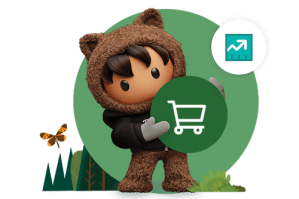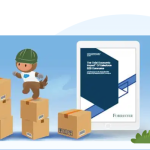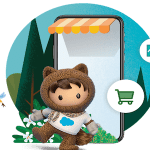B2B vs B2C ecommerce? Understand the major differences between B2B and B2C ecommerce and learn successful strategies to optimise them.
B2B vs B2C: what are the biggest differences and why does this matter?
B2B ecommerce used to be a simple thing: businesses would just put up a website and wait for their customers to come. Now, those days have gone the way of VHS tapes and answering machines.
Today’s ecommerce world is a place of:
24/7 seamless engagement
personalised communication
- omnichannel customer experiences
Businesses don’t sit back and wait for something to happen — they reach out and meet their customers in their favourite spots. This is the anytime, anywhere world of B2C e-commerce, at least.

The B2B e-commerce world still conjures up thoughts of that dusty website, checking its watch and wondering where everyone is. This is changing, though, as today’s B2B buyer is just as digitally savvy as their B2C counterpart — and they expect the same exceptional service. When it comes to B2B vs B2C e-commerce, the gap in service is narrowing.
Let’s take a look at B2B vs B2C e-commerce, and come up with some ways that B2B organisations can offer elevated e-commerce experiences.
What’s the difference between B2B ecommerce and B2C ecommerce?
What is B2B ecommerce?
B2B stands for ‘business to business’ while B2C is ‘business to consumer’. B2B ecommerce utilises online platforms to sell products or services to other businesses. B2C e-commerce targets personal consumers. A company that sells office furniture, software, or paper to other businesses would be an example of a B2B company.
B2B ecommerce tends to be more complex than B2C ecommerce. It involves heavier research, more needs-based purchasing, and less marketing-driven buying. Many B2B buyers have very tight parameters around the purchases they can make. This means that traditional revenue drivers like add-ons don’t have the same impact. B2B organisations didn’t have much of an incentive to optimise their customer journey but this is changing in the current climate.
What is B2C ecommerce?
B2C stands for ‘business to consumer’, referring to transactions where businesses sell products or services directly to individual customers. Examples of B2C businesses include online clothing retailers, streaming services, and food delivery apps—any business selling to the individual.
Compared to B2B, B2C ecommerce is typically more straightforward. Purchasing decisions are usually driven more by personal preference, emotion, convenience, and marketing influence than by institutional needs or budget constraints.
Transforming the B2B Sales Function E-book
Enable sales teams to win the connected customers using B2B Commerce.

B2B vs B2C Ecommerce
For B2B ecommerce, platforms often accommodate custom catalogs, volume discounts, credit terms, and self-service portals. Features such as one-click reordering, saved carts for recurring purchases, and integration with procurement systems are very useful for B2B sales.
Whilst some of these may appear in a B2C context, B2C ecommerce regularly focuses on delivering speed and simplicity: intuitive navigation, mobile-first design, and dynamic product recommendations drive consumer engagement. Today’s buyers expect the best of both worlds –B2B clients demand the same seamless experiences they encounter in B2C environments.
How can your B2B e-commerce platform provide a B2C-level experience?
While B2B e-commerce may be more complex — and the needs of the buyer different – that doesn’t mean those buyers don’t expect the same level of service. Personalisation has been a boon for B2C, but it can be for B2B as well.
Building personal relationships is crucial, especially during the buying cycle. According to the Salesforce State of the Connected Customer report, 72% of business buyers expect vendors to offer personalised engagement.
B2B organisations need to make the most out of every opportunity to connect with their target audience, display a differentiator, and highlight their brand. Here are a few ways that businesses can boost their B2B e-commerce experience:
Create an omnichannel experience
Today’s savvy consumer expects a seamless experience across touchpoints. The business buyer does as well, as 75% of buyers say that they expect vendors to have connected processes. In the same eBook, Transforming the B2B Sales Function, nearly 70% of buyers say that they now expect an “Amazon-like” experience.
Creating an omnichannel experience is a win/win. It enables customers to engage on any channel and offers businesses a wealth of data to better understand their customers.
Offer 24/7 customer support
Since B2B deals with large orders and complex processes, it’s important to offer robust customer support at every stage of the journey. Consider implementing chatbots for 24-hour customer support.
It’s also likely that the B2B buyer has already done some heavy research before approaching (another difference in B2B vs B2C), so consider creating an FAQ section that could answer questions.
Review the checkout process
While offering 24/7 customer support is important, it’s also important to allow customers to help themselves. According to a McKinsey report, 76% of B2B buyers find it helpful to speak to someone when they’re researching a product or service, but only 15% want to speak to someone when reordering. Offering one-click reordering, or even recurring subscriptions, can improve customer satisfaction.
Provide informative content
Since B2B e-commerce purchases aren’t as emotionally driven as B2C e-commerce purchases, it’s important to provide detailed information about products and services. Businesses can implement FAQs, community forums, video demonstrations, live chat, and more.
Another difference in B2B vs B2C is that the B2B buyer will expect their salesperson to thoroughly understand their industry and be well-equipped to answer difficult questions.
What’s next for B2B ecommerce?
Today’s B2B buyers may have higher expectations, but that just means that B2B organisations have to evolve to meet them. This is an opportunity for B2B companies to become more agile, responsive, and connected. And with a Forrester Report stating that 83% of B2B businesses expect to increase their e-commerce sales over the next three years, it’s also an opportunity to grow. When it comes to B2B vs B2C, the clear winner is the customer.
For more insights into the future of B2B ecommerce, download the Forrester Report, B2B Embraces its Omnichannel Commerce Future.
B2B Embraces Its Omnichannel Commerce Future
Did you know an average of 73% of sellers sell through an e-commerce or online sales portal? Learn how B2B companies leverage all channels to drive revenue.





















